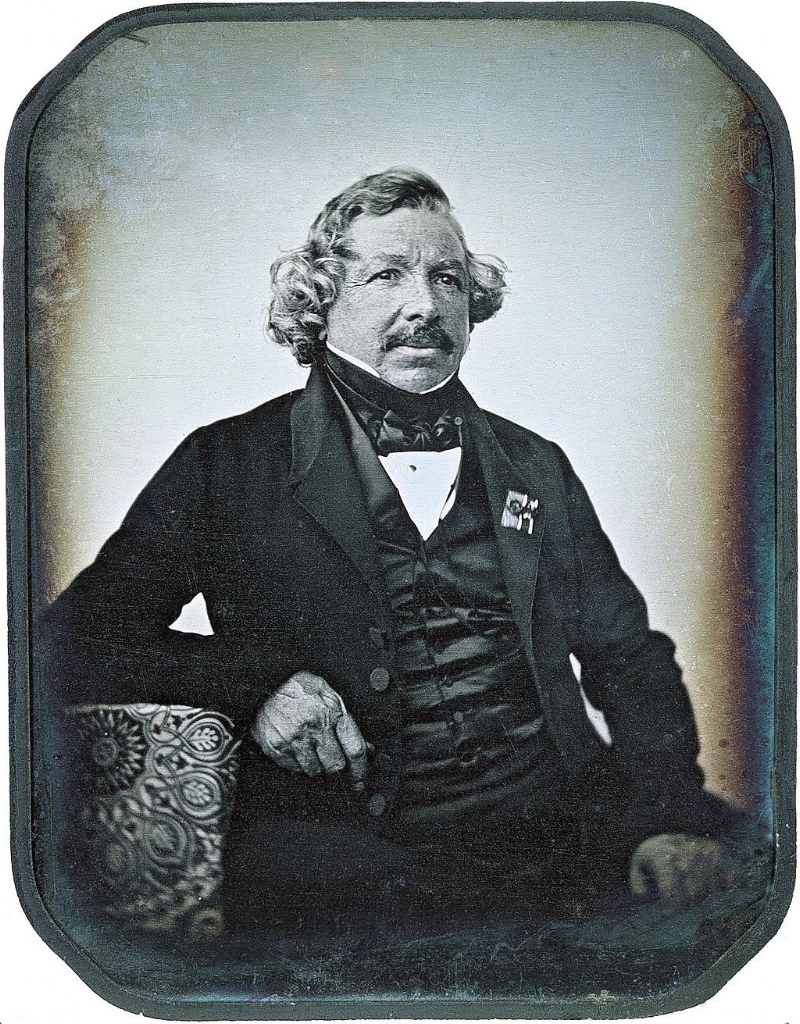Part of the reason I became interested in photography is the science of it and the history that has accompanied the process of going from chemical to digital photography. The first year that photography became viable commercially was in 1839, It was the development of the deguerreotype process by Louis Deguerreo that truly made photography doable and repeatable as before this process it was a hit and miss science. With the D.P. process it only took minutes to process a exposure and it was surprisingly clear and crisp for the time all things considering.
"To make a daguerreotype, the daguerreotyp-ist would polish a sheet of silver-plated copper to a mirror finish, treat it with fumes that made its surface light sensitive, expose it in a camera for as long as was judged to be necessary, which could be as little as a few seconds for brightly sunlit subjects or much longer with less intense lighting; make the resulting latent image on it visible by fuming it with mercury vapor; remove its sensitivity to light by liquid chemical treatment, rinse and dry it, then seal the easily marred result behind glass in a protective enclosure." (excerpt from Wikipedia).
This process actually created in a sense a 3-D image as the picture appeared to float on the surface of the of the metal creating a feeling of realism that is hard to capture even now. For more then twenty years this process was the only way to make photograph reliably.
Daguerreotype of Louis Daguerre in 1844 by Jean-Baptiste Sabatier-Blot
The next real innovation in photography was actually several hundred years in the making. Angelo Sala in 1614 observed that silver nitrate blackened when exposed to sunlight but was dismissed by his peers. It wasn't until 1717, 103 years later, that Johann Heinrich Schulzes a professor accidentally learned about making a image imprint when he left a piece of silver nitrate on his window seal and observed a white line surrounded by blackened silver nitrate. Upon examination he found a thread hanging in his window that would have cast a shadow effectively not exposing part of the silver nitrate. William Henry Fox Talbot would be the man to harness this process to create what we know as a calotype.
"The light-sensitive silver halide in calotype paper was silver iodide, created by the reaction of silver nitrate with potassium iodide. First, "iodised paper" was made by brushing one side of a sheet of high-quality writing paper with a solution of silver nitrate, drying it, dipping it in a solution of potassium iodide, then drying it again. At this stage, the balance of the chemicals was such that the paper was practically insensitive to light and could be stored indefinitely. When wanted for use, the side initially brushed with silver nitrate was now brushed with a "gallo-nitrate of silver" solution consisting of silver nitrate, acetic acid and gallic acid, then lightly blotted and exposed in the camera. Development was effected by brushing on more of the "gallo-nitrate of silver" solution while gently warming the paper. When development was complete, the calotype was rinsed, blotted, then either stabilized by washing it in a solution of potassium bromide, which converted the remaining silver iodide into silver bromide in a condition such that it would only slightly discolor when exposed to light, or "fixed" in a hot solution of sodium thiosulphate, then known as hyposulphite of soda and commonly called "hypo", which dissolved the silver iodide and allowed it to be entirely washed out, leaving only the silver particles of the developed image and making the calotype completely insensitive to light. The calotype process produced a translucent original negative image from which multiple positives could be made by simple contact printing. This gave it an important advantage over the daguerreotype process, which produced an opaque original positive that could only be duplicated by copying it with a camera." (Excerpt from wikipedia)
The calotype could have been far more popular then it was at the time but due to Talbot's patent on the process it slowed down adoption very drastically as he would sue willly nilly anyone who used the same process. Even with his legal aggression the calotype still forms the basis for modern film photography.
Willy smiling by Mary Dillwyn
The desire for pictures arose in the Industrial age from middle class workers and from the rich and wealthy who didn't like to wait or have the time for a oil painting to be completed and delivered. With a photo using the daguerreotype method the picture could be had in just a few hours with prices ranging from 50 cents to over 10 dollars. Doesn't sound like much but if you factor in inflationthat would be 15 dollars to almost 300 dollars per shot. Since it was so hard to produce and store daguerreotype prints eventually people started to turn to calotype photography due to the fact that negatives could be used to produce multiple prints.
That is all for today guys, tomorrow I will discuss how color came into popular use and how the first transportable cameras came about. But as for today have a wonderful evening and a great day !
Sincerely, The BIrd.



